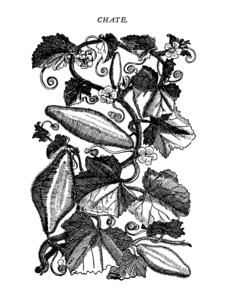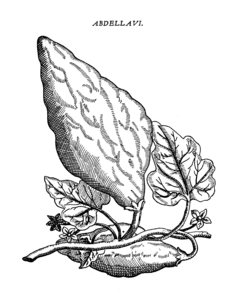Cucumis melo
Cucumis melo L.
| Ordre | Cucurbitales |
|---|---|
| Famille | Cucurbitaceae |
| Genre | Cucumis |
2n = 24
Origine : Aise ou Afrique
sauvage et cultivé
| Français | melon |
|---|---|
| Anglais | melon |
- fruit consommé comme fruit ou légume
- graines mûres utilisées en colliers
Sommaire
- 1 Description
- 2 Noms populaires
- 3 Classification
- 4 Cultivars
- 4.1 Groupe Acidulus
- 4.2 Groupe Adana
- 4.3 Groupe Ameri
- 4.4 Groupe Cantalupensis
- 4.5 Groupe Chandalak
- 4.6 Groupe Chate
- 4.7 Groupe Chinensis
- 4.8 Groupe Chito
- 4.9 Groupe Conomon
- 4.10 Groupe Dudaïm
- 4.11 Groupe Flexuosus
- 4.12 Groupe Inodorus
- 4.13 Groupe Makuwa
- 4.14 Groupe Momordica
- 4.15 Groupe Reticulatus
- 4.16 Groupe Saccharinus
- 4.17 Groupe Tibish
- 5 Histoire
- 6 Usages
- 7 Références
- 8 Liens
Description
Noms populaires
| français | melon |
| anglais | melon, cantaloupe, muskmelon |
| allemand | Melone, Zuckermelone |
| néerlandais | meloen |
| italien | melone, pepone |
| espagnol | melón |
| catalan | |
| portugais | melão ; meloa (formes musquées) |
| polonais | |
| russe | dynja |
| arabe | baṭṭīẖ, qāwūn |
| chinois | |
| japonais | |
| sanscrit | |
| hindi | kharbūzā |
- Voir les noms de la Flore populaire d'Eugène Rolland
Classification
Cucumis melo L. (1753)
synonymes :
- Cucumis collosus (Rottler) Cogn. (1924)
- Cucumis trigonus Roxb. (1832)
- Cucumis melo L. subsp. agrestis (Naudin) Pangalo (1933)
Cultivars
Groupe Acidulus
synonyme :
- Cucumis melo var. acidulus Naudin (1859)
| français | melon |
| anglais | melon |
Melon de forme ellipsoïde, à peau lisse et orange, pulpe blanche et ferme, sans sucres ni arôme, et consommé surtout cuit en Inde.
Groupe Adana
synonyme :
- Melo adana Pangalo (1950)
| français | melon d’Adana, melon d’Astrakan |
| anglais | Adana melon |
| russe | astraxanka |
Melon rond ou allongé, brodé, à peau crème, orange ou brune, pulpe orange ou blanche, avec peu de sucres. Originaire du sud de l’Anatolie et cultivé dans les Balkans, au Proche-Orient, en Ukraine et dans le sud de la Russie.
Groupe Ameri
synonymes :
- Cucumis melo var. ameri Gabaev (1933)
- Melo ameri (Gabaev) Pangalo (1950)
| français | |
| anglais | summer melon |
melon ellipsoïde allongé, gros, à peau jaune ou vert clair, sans côtes, légèrement brodé, à pulpe blanche (parfois orange), sucré mais à faible arôme. Cultivé en Asie centrale et en Iran.
Groupe Cantalupensis
synonyme :
- Cucumis melo var. cantalupensis Naudin (1859)
| français | melon cantaloup, melon charentais |
| anglais | rock melon, ribbed melon |
| allemand | Kantalupmelone |
| italien | melone cantalupo, zatta |
| portugais | meloa |
Groupe Chandalak
synonymes :
- Melo chandalak Pangalo (1950)
- Adzhur Group
| français | melon |
| anglais | ball melon, early melon |
Melon aplati à rond, avec ou sans côtes, à peau verte à jaune, parfois ridée ou brodée, à pulpe blanche ou verte, sucré mais à arôme faible, précoce. Originaire d’Asie centrale et d’Iran, où il reste cultivé.
Groupe Chate
synonymes :
- Cucumis chate Hasselquist (1757)
- Cucumis melo var. chate (Hasselquist) Filov (1960)
| français | melon |
| anglais | cucumber melon |
| italien | carosello, cocomerazzo, cucummeru |
| espagnol | alficoz, badea |
| arabe | faqqūs (Afrique du Nord), ‘abd-al-lāawī (Égypte) ; قثا - qaṯṯa (Avicenne) |
Groupe Chinensis
synonyme :
- Melo chinensis Pangalo (1950)
| français | melon |
| anglais | melon |
Melon piriforme, souvent semi-infère (comme une courge-turban), à peau vert clair ou foncé, tachetée, à pulpe verte ou orange, contenu en sucre moyen, sans arôme. Cultivé en Asie de l’Est.
Groupe Chito
synonyme :
- Cucumis melo var. chito (C. Morren) Naudin (1859)
Les fruits sont petits, ronds, lisses, marbrés, d’abord verts puis jaunes. La pulpe est acide, blanche. Ces melons ornementaux ont été cultivés dans le sud de l’Europe et aux États-Unis. Ils seraient surtout connus à l’état subspontané en Amérique centrale.
Groupe Conomon
synonymes :
- Cucumis melo var. acidulus Naudin (1859)
- Cucumis melo var. conomon (Thunb.) Makino (1902)
- Cucumis conomon Thunberg (1780)
| français | |
| anglais | Chinese pickling melon, Chinese white cucumber |
| hindi | phūṭ |
| chinois | yuè guā ; ts’it kwa, uet kwa (cantonais) |
| japonais | uri, shiro uri |
Groupe Dudaïm
synonymes :
- Cucumis melo var. dudaim (L.) Naudin (1859)
- Cucumis dudaim L. (1753)
| français | melon rouge de Perse, melon de senteur, melon de la reine Anne |
| anglais | Queen Anne’s pocket melon, mango melon, pomegranate melon |
| espagnol | meloncito de olor |
| arabe | šammām, šammām abu rīḥa |
| persan | dastambū |
Groupe Flexuosus
synonymes :
- Cucumis melo var. flexuosus (L.) Naudin (1859)
- Cucumis flexuosus L. (1763)
| français | melon serpent, concombre serpent |
| anglais | snake melon, serpent melon |
| allemand | Schlangenmelone ; Gurken-Melone |
| italien | tortarello, melone spurio |
| portugais | melão serpentino |
| arabe | qaṯṯā’ (Égypte) |
| turc | acur |
| chinois | cài guā |
Groupe Inodorus
synonymes :
- Zard Group
- Cucumis melo var. inodorus (L.) Naudin (1859)
| français | melon d’hiver ; melon d’eau |
| anglais | winter melon ; Honeydew (États-Unis) |
| allemand | Wintermelone, Persische Melone |
| italien | melone vernino |
| portugais | melão |
Groupe Makuwa
Melon aplati, globuleux, ellipsoïde ou piriforme, souvent semi-infère (comme une courge-turban), à peau lisse, blanche, jaune ou vert clair, à pulpe blanche, sucrée mais avec peu d’arôme, précoce. Cultivé en Asie de l’Est.
Groupe Momordica
synonyme :
- Cucumis momordica Roxb. (1832)
| français | melon |
| anglais | snap melon |
| hindi | kakṛī, phūṭ |
Groupe Reticulatus
synonyme :
- Cucumis melo var. reticulatus Naudin (1859)
| français | melon brodé |
| anglais | netted melon ; cantaloupe, muskmelon (États-Unis) |
| allemand | Netzmelone |
| italien | melone retato |
Groupe Saccharinus
synonyme :
- Cucumis melo var. saccharinus Naudin (1859)
| français | melon sucrin |
| anglais | sugar melon |
Groupe Tibish
| français | melon tibish |
| anglais | tibish melon |
Histoire
Chate Alpin 1735, De Plantis Aegypti, 45v ; 54
Abdellavi Alpin 1735, De Plantis Aegypti, 46r ; 55
Usages
- Voir les Plantes médicinales de Cazin (1868)
Références
- Andrews, A.C., 1956. Melons and watermelons in the classical era. Osiris, 12 : 368-375.
- Casacuberta, Josep ; Puigdomènech, Pere & Garcia-Mas, Jordi, 2016. The Melon Genome. In: Grumet, R., Katzir, N., & Garcia-Mas, J., (eds). Genetics and Genomics of Cucurbitaceae. Plant Genetics and Genomics: Crops and Models, vol 20. Springer. 173-181. doi : 10.1007/7397_2016_5
- Chauvet, Michel, 2018. Encyclopédie des plantes alimentaires. Paris, Belin. 880 p. (p. 212)
- Goldman, Amy, ?. Melons for the passionate grower
- Grebenščikov, Igor, 1953. Die Entwicklung der Melonensystematik. Kulturpflanze, 1 : 121-138.
- Gur, Amit et al., 2016. Genomic Aspects of Melon Fruit Quality. In: Grumet, R., Katzir, N., & Garcia-Mas, J., (eds). Genetics and Genomics of Cucurbitaceae. Plant Genetics and Genomics: Crops and Models, vol 20. Springer. 377-408. doi : 10.1007/7397_2016_29
- Hammer, Karl; Hanelt, Peter et Perrino, Pietro, 1986. Carosello and the taxonomy of Cucumis melo L. especially of its vegetable races. Kulturpflanze, 34 : 249-259.
- Jacquin M., 1832. Monographie complète du melon, contenant la culture, la description et le classement de toutes les variétés de cette espèce, suivies de celles de la pastèque à chair fondante avec la figure de chacune dessinée et colorée d'après nature. Paris, Rousselon. 199 p., 33 pl. h.t.
- Janick, J. & Paris, Harry, 2008. Reflections on linguistics as an aid to taxonomical identification of ancient Mediterranean cucurbits: the Piqqus of the Faqqous. in Cucurbitaceae 2008. Proceedings of the IXth EUCARPIA meeting on genetics and breeding of Cucurbitaceae, Pitrat M. ed.. Avignon, INRA. pp. 43-51.
- Kerje, Torbjörn & Grum, Mikkel, 2000. The origin of melon, Cucumis melo: a review of the literature. in Proceedings of Cucurbitaceae 2000, Katzir, N. & Paris, H.S. eds. Acta Hort., 510: 37-44.
- Leppik, E.E., 1966. origine du melon ?
- Lost Crops of Africa. Volume III: Fruits, 2008. Washington, National Academies Press. 380 p. en ligne
- Lovegren, Sylvia, 2016. Melon : A Global History. Reaktion Books. 144 p.
- Mohamed, El Tahir I. & Pitrat, Michel, 1999. Tibish, a melon type from Sudan. Cucurbit Genet. Coop. Rep., 22 : 21-23.
- Munger, H. & Robinson, R.W., 1991. Nomenclature of Cucumis melo L. Cucurbit Genet. Coop. Rep., 14 : 43-44.
- Nerson, Haim; Paris, Heey S. & Edelstein, Menahem, 1990. Melofon : a new crop for concentrated yield of pickles. in Janick, Jules & Simon, James E. (eds), Advances in new crops. Portland (Oregon), Timber Press. pp. 399-402. (Cucumis melo comme cornichons).
- Pangalo, K.I., 1930. [Critical survey of the principal literature on the systematics, geography and origin of cultivated and, partly, wild growing melons]. Trudy po prikl. Bot., 23(3) : 397-449.
- Pangalo, K.I., 1930. [Chinese melons]. Bjul. prikl. Bot., 23 : 545-560.
- Paris, Harry S. & Janick, J., 2008. What the Roman emperor Tiberius grew in his greenhouses. in Cucurbitaceae 2008. Proceedings of the IXth EUCARPIA meeting on genetics and breeding of Cucurbitaceae, Pitrat, M. ed. Avignon, INRA. pp. 33-41.
- Paris, Harry S.; Amar, Zohar & Lev, Efraim, 2012. Medieval emergence of sweet melons, Cucumis melo (Cucurbitaceae). Ann Bot., 110 (1): 23-33.
- Pitrat, Michel, 2005. Ressources génétiques, diversité et amélioration du melon. Le Sélectionneur français, 55 : 3-12.
- Pitrat, Michel, 2016. Melon Genetic Resources: Phenotypic Diversity and Horticultural Taxonomy. In: Grumet, R., Katzir, N., & Garcia-Mas, J., (eds). Genetics and Genomics of Cucurbitaceae. Plant Genetics and Genomics: Crops and Models, vol 20. Springer. 25-60. DOI 10.1007/7397_2016_10
- Pitrat, Michel; Hanelt, Peter & Hammer, Karl, 2000. Some comments on infraspecific classification of cultivars of melon. in Proceedings of Cucurbitaceae 2000, Katzir N. and Paris H.S. eds. Acta Hort., 510: 29-36.
- Pyzhenkov, V.I., 1994. Kuljturnaja Flora. Tom XXI. Tykvennye (Ogurets, Dynia) / Flora of Cultivated Plants. Volume XXI. Cucurbitaceae (Cucumis sativus L., Cucumis melo L.). Moskva, Kolos. 288 p.
- Sebastian, Patrizia ; Schaefer, Hanno ; Telford, Ian R. H. & Renner Susanne S., 2010. Cucumber (Cucumis sativus) and melon (C. melo) have numerous wild relatives in Asia and Australia, and the sister species of melon is from Australia. PNAS, 107 (32) : 14269–14273.
- Seshadri, V.S. & More, T.A., 2002. Indian land races in Cucumis melo. in Proc. 2nd International Symposium on Cucurbits (eds. S. Nishimura et al.). Acta Hort., 588: 187-193.
- Tapley, W. T.; Enzie, W. D. & van Eseltine, G. P., 1937. The vegetables of New-York, Vol. 1, Part IV, The cucurbits. N.Y. Agric. Exp. Sta., Geneva. (Cucurbits, p. 473-661 du pdf)
- Yano, Ryoichi & Ezura, Hiroshi, 2016. Fruit Ripening in Melon. In: Grumet, R., Katzir, N., & Garcia-Mas, J., (eds). Genetics and Genomics of Cucurbitaceae. Plant Genetics and Genomics: Crops and Models, vol 20. Springer. 345-375. doi : 10.1007/7397_2016_11
Liens
- BHL
- Collection Nationale de Cucurbitacées (CCVS) : melo, flexuosus et momordica
- FAO Ecocrop
- Feedipedia
- Flora of China
- Grieve's herbal
- GRIN
- IPNI
- Lost Crops of Africa
- Mansfeld
- Moerman, Native American Ethnobotany
- Multilingual Plant Name Database
- NewCrop Purdue
- Plant List
- Plants for a future
- PROSEA sur Pl@ntUse
- PROTA sur Pl@ntUse
- Tela Botanica
- Useful Tropical Plants Database
- Wikipédia







